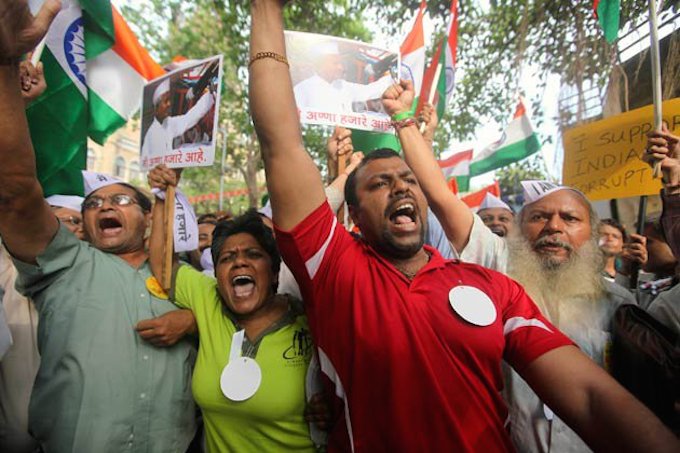It was a no-brainer, really.
Why had no major political party in India ever thought to fight the national elections on the plank of corruption? No one, that is, till the Aam Aadmi Party (AAP, or ‘the common man’s party’) burst histrionically upon the nation’s television screens, their volunteers waving coconut brooms in a symbolic cleansing of the grubby Indian political scene.
It is surprising because citizens had been coughing up their taxes these 60-odd years since the country became independent, but plainly not all of it had found its way into supporting the provision of essential, functional services like drinking water, sanitation, roads, pavements, decent government schools, hospitals and law-and-order infrastructure.
For years political parties fought elections running emotionally-charged campaigns on poverty, religion and caste identity, but no one till the AAP thought to go to the hustings saying something had to be done about endemic corruption, which has scored India the 94th spot on Transparency International’s Corruption Perceptions Index for the second year in a row.
The AAP sprang from a national anti-corruption movement in 2011, headed by septuagenarian activist Anna Hazare. Its aim was to get the government to appoint an ombudsman to hear corruption cases great and small. This required the passage of what was known as the the Jan Lokpal Bill.
The party proved itself, and its appeal to a jaded electorate, during the 2013 assembly elections in Delhi. Former engineer turned tax bureaucrat Arvind Kejriwal of the AAP defeated incumbent chief minister Sheila Dikshit of the Congress party. AAP even managed to run a bumbling state government for 49 days.
The party has since then upped stakes claiming it was not allowed to bring in a Lokpal Bill for Delhi, which many saw as a flimsily-devised escape hatch to allow itself an exit to fight the bigger battle of the 2014 national elections.
Nobody really thinks they can win, but then they were also perceived as outsiders in the electoral system, consisting of the usual suspects — career politicians and their children, during the Delhi elections. That perception quickly and dramatically changed when they won 28 seats spoiling a straight-out victory for the Bharatiya Janata Party (BJP).
Electoral fights are almost gladiatorial nowadays; friends and foes fight each other as if there was no tomorrow. Yet, in the end, in an era when absolute majority is elusive, it boils down to this: common ground must be found and alliances forged so that governments can be run. But the AAP at least thus far seems to show no interest in the politics of finding strategically convenient running mates.
In India, no single party has had the luxury of numbers since 1989, when the Congress under then Prime Minister Rajiv Gandhi, let a two-thirds majority slip away at the Lok Sabha elections. Pre-poll surveys suggest that this time the BJP-led National Democratic Alliance will hold sway, though it will need some additional support for government formation, and the Congress-led United Progressive Alliance is heading for a rout after 10 years in government. There are ‘the others’, of course. But that’s for another article.
This year, more than the result and winners and losers, the big story could be about who’s contesting from which party. The means to reaching the end is under scrutiny more than ever before — largely because of AAP.
The party has already got the established players thinking on this count. Its recent manoeuvres suggest it won’t be missing a chance to wash dirty linen in public and bring out skeletons from cupboards if other parties field corruption-tainted candidates.
AAP champions itself on probity and has shown it knows best how to use the Right To Information Act, which is slowly but surely showing the way against corruption by allowing citizens to question and petition governments, and by law these questions now require answers. Before Right To Information, there was obfuscation and bribe-giving. Now, if programs are not implemented and funds are siphoned off, citizens have the right to seek explanations.
AAP has already announced a first list of its candidates — activists like Medha Patkar of the Narmada movement and Anjali Damania, psephologist and academic plus AAP ideologue Yogendra Yadav and professionals like former banker Meera Sanyal, who quit her job as the head of the Royal Bank of Scotland in India to join up in the struggle against corruption.
AAP is known for its unconventional campaigning style, as seen in the Delhi assembly elections. Kejriwal travelled everywhere in a pint-sized blue hatchback and used the Delhi metro to go to his investiture ceremony as Chief Minister, stubbornly repudiating the pomp and power of state symbols.
After the crushing defeat in the Delhi elections, even Congress vice-president Rahul Gandhi commented that his party could learn a thing or two from the political outfit put together by Kejriwal. In public, the BJP has been dismissive of AAP’s fortunes in the upcoming elections, but people in the know say there are some worry lines in the party.
AAP’s brooms have changed the landscape, even if there’s still a lot of dark corners to be swept clean.



